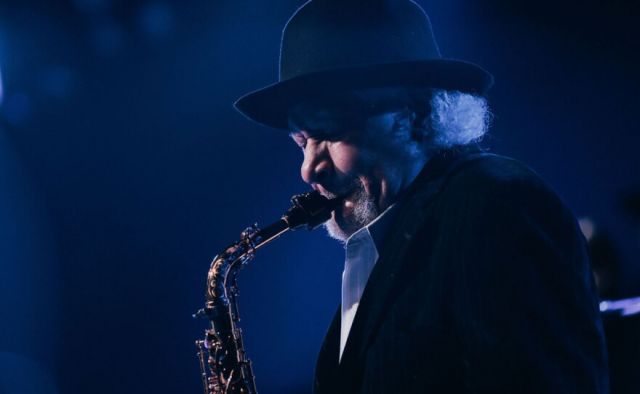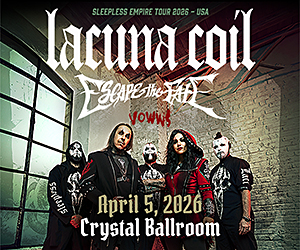Home > Jazz / Blues
02/21/2022
Gary Bartz, the 11pm set 2/19/2022 at Jack London Revue / PDX Jazz Festival 2022
By MICHAEL SHOEHORN CONLEY // At age 81, Mr. Gary Bartz, the embodiment of old-school hipness, was also on display here, working the mic with the relaxed cadence of an affable beatnik uncle.
If anyone meets the description of a jazz saxophonist straight from “central casting”, Gary Bartz would be in contention, looking slim in black pants and shirt, a white sportcoat splattered with bright colors, and crowned with a cloud of white hair befitting an elder statesman of the music. At age 81, Mr. Gary Bartz, the embodiment of old-school hipness, was also on display here, working the mic with the relaxed cadence of an affable beatnik uncle.
I caught the 11pm set at the Jack London Revue by the altoist, leading a rhythm trio of local players– George Colligan, keyboard, Christopher Brown, drums, and Christian Ramirez on upright bass.
Bartz made all of his announcements prior to playing, henceforth segueing from one song to the next to craft an uninterrupted flow of creative musicianship. He did introduce the first number, “Capuchin Swing”, written by Jackie McLean, and titled for McClean’s pet monkey. It had a familiar ring to it– the tune is a contrafact on the standard “Star Eyes”, something that became more obvious as the rendition progressed.
Right out of the gate Bartz demonstrated an ability to traverse fluidly between bebop vocabulary and a palette of extended techniques brought to the music by players in the 1960s, including harmonics and multiphonics reminiscent of Eric Dolphy and John Coltrane.
Next, Bartz played a rubato intro that sounded a lot like the hook from the Earth, Wind & Fire ballad Fantasy before embarking on an excursion anchored by a fusion groove laid down by bassist Ramirez. Ramirez utilized an array of electronics more typically deployed by electric bassists to achieve augmented tonal colors and distorted sounds. These included the synth parts Bartz used as a springboard to launch into some dissonant, funky wailing, grabbing some low thwacks from the bottom of the horn and bouncing back up through the registers, fingers scrambling over the keys.
Colligan brought some raucous 70s keyboard sounds to this one, sounding like a clavinet going through outboard pedals. The tune had a short, compelling unison theme tying the blowing sections together.
After this the band shifted gears, Bartz playing the first notes of “Just Friends”, the well-loved standard, then uncorking some smoking 16th-note runs throughout the range of the horn, fingers flying again. Here the rhythm section maintained an acoustic jazz sound, Colligan using a piano patch on his keyboard and the bassist going straight-up acoustic. Some of Bartz’s lines on this one sounded almost through-composed, as if he may have played them before, but he was definitely bringing his own flavor to the songbook classic.
The next song kicked off at a burning tempo north of 240 beats a minute, with a tricky stutter-step unison line by the piano and sax, giving way to more intense blowing by the leader. Drummer Christopher Brown delivered a compelling unaccompanied solo on this up-tempo piece.
“The Song of Loving-Kindness" brought to mind “Precious Energy”, Bartz's seminal 1970s album with the singer (and jazz yodeler!) Leon Thomas. This piece features a gentle melody offset by a wide-interval swoop to a low note that ricochets off the bottom of the horn, a low note which had some edge to it due to Bartz's use of a clip-on microphone, which caused some distortion. The core gentleness of this tune came to the fore after the sax solo when Bartz, exuding harmonious goodwill, repeatedly chanted the title, which doubles as the words to the refrain. “The Song of Loving-Kindness" indeed.
All of it was consistent with the overall presentation, as throughout the performance Bartz exhibited a thorough command of the sweet and sour flavors of the alto saxophone.
The rhythm section deserves praise for hanging with the protean flow of this set. The powerful bass solos by Ramirez included some interesting, muscular manipulations using only his left hand on the fingerboard. His startling use of electronics made me wonder why I have never before seen an upright bassist add these types of effects. Brown was taut and crisp at tempo, and an adept colorist in the free segments. Colligan sounded inspired here. A stalwart of the Portland Music scene, he has vast experience as a sideman touring the circuit with many of the music’s great players.
Bartz was done working by now. He introduced the band and thanked the audience, but they stayed onstage and after a couple of minutes delivered an encore in the form of a blues, the blues being the common language of American music. It was a treat to hear Gary Bartz deliver chorus after chorus of beautiful blues playing at a relaxed tempo. Again, Colligan took a potent solo, at one point subtly inserting a quote from Thelonious Monk’s iconic composition “Crepuscule with Nellie”
I appreciated this chance to see this alto sax icon, as I was unable to attend the 7pm concert at the Winningstad Theatre earlier that evening. I want to encourage the Biamp PDX Jazz Festival to make these late sets an ongoing tradition.








